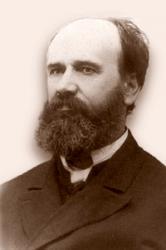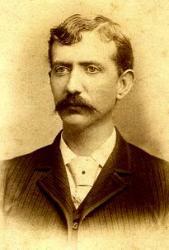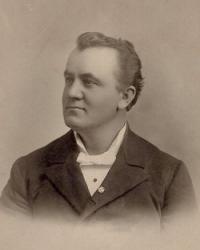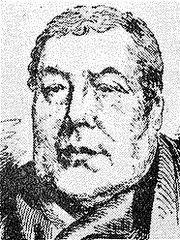Planning worship?
Check out our sister site, ZeteoSearch.org,
for 20+ additional resources related to your search.
- |
User Links
Person Results
‹ Return to hymnal









Export as CSV
C. C. Case

1843 - 1918 Hymnal Number: 49 Composer of "[While we pray and while we plead]" in Great Revival Hymns Charles Clinton Case USA 1843-1918. Born in Linesville, PA, his family moved to Gustavus, OH, when he was four. His father was an accomplished violinist, but a neighbor gave him a small violin when he was nine, and he mastered it before he could read music. At age 16 he went to singing school (without parental consent), borrowing the money from a neighbor. C. A. Bentley, a prominent conductor, was his first vocal music instructor, and William Bradbury's “Jubilee” was the school textbook. For three winters in a row, he attended Bentley's singing school, working his father's farm in the summer. He married Annie Williams. In 1866 he studied music in Boston with B. F. Baker. He also studied under George Root, Horatio Palmer, Philip Bliss, George Webb, and others, hymnwriters in their own right. Soon after, Case began teaching music, and when James McGranahan moved two miles from his home, they became friends. Case wrote and edited a number of Gospel song books in his life. 6 works.
John Perry
C. C. Case
A. B. Simpson

1843 - 1919 Hymnal Number: 68 Author of "Some Sweet Morn" in Great Revival Hymns Albert B. Simpson was the founder of The Christian and Missionary Alliance.
Dianne Shapiro
A. B. Simpson
Thomas O. Chisholm

1866 - 1960 Person Name: T. O. Chisholm Hymnal Number: 126 Author of "It Is Jesus" in Great Revival Hymns Thomas O. Chisholm was born in Franklin, Kentucky in 1866. His boyhood was spent on a farm and in teaching district schools. He spent five years as editor of the local paper at Franklin. He was converted to Christianity at the age of 26 and soon after was business manager and office editor of the "Pentecostal Herald" of Louisville, Ky. In 1903 he entered the ministry of the M. E. Church South. His aim in writing was to incorporate as much Scripture as possible and to avoid flippant or sentimental themes.
Dianne Shapiro, from "The Singers and Their Songs: sketches of living gospel hymn writers" by Charles Hutchinson Gabriel (Chicago: The Rodeheaver Company, 1916)
==============================
Signed letter from Chisholm dated 9 August 1953 located in the DNAH Archives.
Thomas O. Chisholm
Edith Sanford Tillotson

1876 - 1968 Hymnal Number: 160 Author of "Song to the Flag" in Great Revival Hymns Edith Sanford Tillotson was born and lived her entire life in Corona, New York. She wrote hymns for children as well as poems and librettos.
Dianne Shapiro, from "The Singers and Their Songs: sketches of living gospel hymn writers" by Charles Hutchinson Gabriel (Chicago: The Rodeheaver Company, 1916)
Edith Sanford Tillotson
Russell Kelso Carter

1849 - 1928 Person Name: R. K. C. Hymnal Number: 299 Author of "Standing on the Promises" in Great Revival Hymns Russel Kelso Carter was a professor in the Pennsylvania Military College of Chester. While there he was licensed to preach by the Methodist Episcopal Church. He became very active in leading camp meetings and revivals. After failing health forced him to abandon this work, he studied and became a medical doctor as well as a writer. He wrote novels as well as hymns.
Dianne Shapiro, from "The Singers and Their Songs: sketches of living gospel hymn writers" by Charles Hutchinson Gabriel (Chicago: The Rodeheaver Company, 1916)
Russell Kelso Carter
John Wyeth
1770 - 1858 Hymnal Number: 252 Composer of "[Come, Thou Fount of every blessing]" in Great Revival Hymns
John Wyeth
Cyrus S. Nusbaum

1861 - 1937 Person Name: C. S. N. Hymnal Number: 30 Author of "Jesus Is the Best Friend to Me" in Great Revival Hymns Rv Cyrus Sylvester Nusbaum DD USA 1861-1937. Born at Middlebury, IN, he completed his education and taught school in Marion County, KS. In 1886 he married Harriett Eleanor Erwin, and they had two children: Hazel and Mark. That year he was ordained a Methodist minister and pastored at Douglass, Goddard, Wichita, and Kingman, KS. He served as educational secretary at Southwestern College, Winfield, KS, 1895-1897. He pastored at Ottawa, KS, 1897-1903. He became presiding elder of the Independent District, 1903-1907, and pastor at Parsons, KS, 1908-1914. In 1914 he was appointed an evangelist for the Methodist Conference. During WW1 he was a US Army Captain working as an American Red Cross inspector in France. After the war, he often spoke on the Redpath Lyceum circuit and held evangelistic meetings in KS, NE, OK, and TX. Southwestern College conferred a DD degree upon him. In latter years, he served small KS churches and was a “supply preacher” at Lost Springs and Antelope. He died at Wichita, and was buried in Kingman, KS.
Special note: His hymn, noted below, was written after his first year of trying to preach at seven different locations simultaneously on a very low salary, a very difficult task. He was tired and discouraged. At the annual conference meeting he was hoping for a better appointment, but was reassigned to the same circuit. He was unhappy and rebellious in spirit about it, but, upon retiring at the lodging place for the night, he stayed up late after his wife had retired for the night. About midnight he knelt in prayer and told God he could have his way regardless of the cost. It inspired him to write the hymn (both words and music).
John Perry
Cyrus S. Nusbaum
Josiah Hopkins

1786 - 1862 Person Name: Josiah Hopkins Hymnal Number: 207 Author of "Expostulation" in Great Revival Hymns Hopkins, Josiah , D.D., was born at Pittsford, Vermont, April 13, 1786. From 1809 to 1830 he was pastor of a Congregational Church, at New Haven, Vermont; and from 1830 to 1848 of the First Presbyterian Church, Auburn, New York. He died at Geneva, New York, July 27, 1862. He was the editor of Conference Hymns , Auburn, 1846, and contributed hymns to the Christian Lyre , N. Y., 1830. From the latter work his hymns in common use are taken:—
1. 0 turn ye, 0 turn ye, for why will ye die. Expostulation.
2. Why sleep we, my brethren. Expostulation.
[Rev. F. M. Bird, M.A.]
-- John Julian, Dictionary of Hymnology (1907)
Josiah Hopkins
Samuel Webbe

1740 - 1816 Hymnal Number: 267 Composer of "[Come, ye disconsolate, where’er ye languish]" in Great Revival Hymns Samuel Webbe (the elder; b. London, England, 1740; d. London, 1816) Webbe's father died soon after Samuel was born without providing financial security for the family. Thus Webbe received little education and was apprenticed to a cabinetmaker at the age of eleven. However, he was determined to study and taught himself Latin, Greek, Hebrew, French, German, and Italian while working on his apprenticeship. He also worked as a music copyist and received musical training from Carl Barbant, organist at the Bavarian Embassy. Restricted at this time in England, Roman Catholic worship was freely permitted in the foreign embassies. Because Webbe was Roman Catholic, he became organist at the Portuguese Chapel and later at the Sardinian and Spanish chapels in their respective embassies. He wrote much music for Roman Catholic services and composed hymn tunes, motets, and madrigals. Webbe is considered an outstanding composer of glees and catches, as is evident in his nine published collections of these smaller choral works. He also published A Collection of Sacred Music (c. 1790), A Collection of Masses for Small Choirs (1792), and, with his son Samuel (the younger), Antiphons in Six Books of Anthems (1818).
Bert Polman
Samuel Webbe
Ira David Sankey

1840 - 1908 Person Name: Ira D. Sankey Hymnal Number: 51 Composer of "[I have a Savior, He's pleading in glory]" in Great Revival Hymns Sankey, Ira David, was born in Edinburgh, Pennsylvania, in 1840, of Methodist parents. About 1856 he removed with his parents to New Castle, Pennsylvania, where he became a member of the Methodist Episcopal Church. Four years afterwards he became the Superintendent of a large Sunday School in which he commenced his career of singing sacred songs and solos. Mr. Moody met with him and heard him sing at the International Convention of the Young Men's Christian Association, at Indianapolis, and through Mr. Moody's persuasion he joined him in his work at Chicago. After some two or three years' work in Chicago, they sailed for England on June 7, 1872, and held their first meeting at York a short time afterwards, only eight persons being present. Their subsequent work in Great Britain and America is well known.
Mr. Sankey's special duty was the singing of sacred songs and solos at religious gatherings, a practice which was in use in America for some time before he adopted it. His volume of Sacred Songs and Solos is a compilation from various sources, mainly American and mostly in use before. Although known as Sankey and Moody’s Songs, only one song, "Home at last, thy labour done" is by Mr. Sankey, and not one is by Mr. Moody. Mr. Sankey supplied several of the melodies. The English edition of the Sacred Songs & Solos has had an enormous sale; and the work as a whole is very popular for Home Mission services. The Songs have been translated into several languages.
--John Julian, Dictionary of Hymnology (1907)
Pseudonymns:
Harry S. Lower
Rian A. Dykes
====================
Sankey, I. D., p. 994, i. During the past fifteen years Mr. Sankey's Sacred Songs and Solos have had a very large sale, which has justified him in increasing the number of songs and hymns, including " New Hymns and Solos," to 1200. In 1906 he published My Life and Sacred Songs (London : Morgan & Scott). In addition to the "Story of his Own Life," the work contains an account of the most popular of his solos, with interesting reminiscences of the spiritual awakening of many who were influenced through his singing of them in public. In this respect it corresponds in some measure with G. J. Stevenson's Methodist Hymn Book, &c, 1883 (p. 1094, i.). It is an addition to the Sacred Songs and Solos, which will be held in esteem by many. In addition to his hymn, noted on p. 994, ii., Mr. Sankey gives details of the following:—
1. Out of the shadow-land into the sunshine. [Heaven Anticipated.] Mr. Sankey's account of this hymn is:—
"I wrote this hymn specially for the memorial service held for Mr. Moody in Carnegie Hall, where 1 also sang it as a solo. It is the last sacred song of which I wrote both the words and music. The idea was suggested by Mr. Moody's last words, 'Earth recedes; heaven opens before me . . . God is calling me, and I must go.' On account of its peculiar association with my fellow-labourer in the Gospel for so many years, the words are here given in full."
The hymn follows on p. 185, in 3 stanzas of 4 lines and a chorus.
2. Rejoice! Rejoice! our King is coming, [Advent.] Mr. Sankey writes concerning this hymn:—
"During one of my trips to Great Britain on the SS. City of Rome a storm raged on the sea. The wind was howling through the rigging, and waves like mountains of foam were breaking over the bow of the vessel. A great fear had fallen upon the passengers. When the storm was at its worst, we all thought we might soon go to the bottom of the sea. The conviction came to me that the Lord would be with us iu the trying hour, and sitting down in the reading room, I composed this hymn. Before reaching England the tune had formed itself in my mind, and on arriving in London I wrote it out, and had it published in Sacred Songs and Solos, where it is No. 524 in the edition. of 1888.
From Mr. Sankey's autobiographical sketch we gather that he was born at Edinburgh, in Western Pennsylvania, Aug. 28, 1840, joined Mr. Moody in 1871, and visited England for the first time in 1873. The original of the Sacred Songs, &c, of 23 pieces only, was offered as a gift to the London publishers of P. Phillips's Hallowed Song, and declined by them. It was subsequently accepted by Mr. K. O. Morgan, of Morgan & Scott, and is now a volume of 1200 hymns.
From a return kindly sent us by Messrs. Morgan & Scott, we find that the various issues of the Sacred Songs and Solos were:—
In 1873, 24 pp.; 1874, 72 pp. ; 1876, 153 hymns; 1877, 271 hymns; 1881, 441 hymns; 1888, 750 hymns; 1903, 1200 hymns.
In addition, The Christian Choir, which is generally associated with the Sacred Songs and Solos, was issued in 1884 with 75 hymns, and in 1896 with 281. The New Hymns & Solos, by the same firm, were published in 1888.
--John Julian, Dictionary of Hymnology, New Supplement (1907)
Ira David Sankey


 My Starred Hymns
My Starred Hymns


